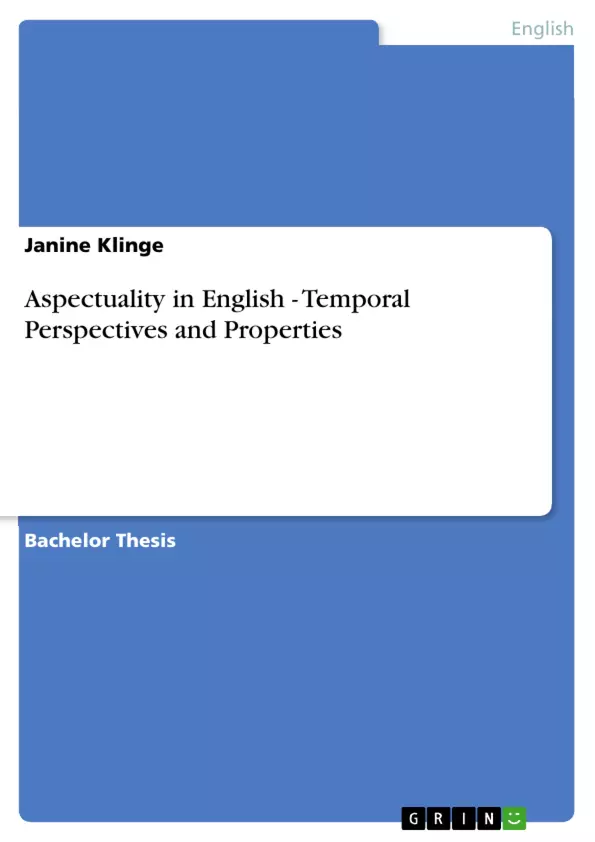This paper aims at a closer examination of aspectuality in English. It illustrates the importance of a category which has only scarcely received attention in the study of the English language (cf. Binnick 1991). When it comes to the analysis of situations, the focus is on the verbal category 'tense,' which relates the temporal location of the situation to other points in time. The category of 'aspect' is closely connected to tense, because it provides important information about the internal temporal structure of situations. Nonetheless it is often less familiar to speakers of the English language, referring to, among others, the works of Comrie (1967), Brinton (1988), Binnick (1991) and Kortmann (1991). According to their studies, English lacks formal markers of aspect, whereas the realization of tense in English is quite obvious and thus much
discussed.
1.1 Central Questions
Based on Binnick's (1991) description of 'aspectuality,' it is necessary to clarify this
concept in detail. The central questions for this examination will be:
1. How can aspectuality be inferred from utterances when English lacks aspectual markers?
2. Are there systematic approaches that are concerned with the interaction of 'aspect' and 'Aktionsart' as defined by Comrie (1976) and Vendler (1957)?
3. In which ways do aspectual properties influence or change the semantic meaning of utterances and why?
4. What are the combination options of aspectual perspectives and properties and are there any restrictions consequent on the interaction of different aspectual values?
This paper serves not just to answer these questions, but also tries to differentiate between the various subcategories of aspectuality,' which are in general difficult to distinguish properly. [...]
Inhaltsverzeichnis (Table of Contents)
- 1 Introduction
- 1.1 Central Questions
- 1.2 Corpus Material
- 2 Literature Review
- 2.1 Aspectuality
- 2.1.1 Aspect
- 2.1.2 Aktionsart
- 2.2 Summary
- 2.1 Aspectuality
- 3 The Structure of Situations
- 3.1 Telicity and aspectual perspectives
- 3.2 Verb semantics and aspect meaning
- 4 Results and Explanations
- 5 Conclusion
- 6 References
Zielsetzung und Themenschwerpunkte (Objectives and Key Themes)
This paper aims to investigate aspectuality in English, a category that has received limited attention in the study of the language. It seeks to illustrate the significance of this category in understanding the internal temporal structure of situations, highlighting its close connection to the more familiar concept of tense. The paper aims to demonstrate how aspectuality can be inferred from utterances in a language that lacks explicit aspectual markers.
- The definition and nature of aspectuality in English
- The role of tense in relation to aspect
- The connection between aspect and the internal structure of situations
- The methods of inferring aspectuality in English
- The significance of aspectuality in analyzing temporal relations in language
Zusammenfassung der Kapitel (Chapter Summaries)
The introduction provides an overview of the study of aspect and its importance for understanding how temporal relations are expressed in language. It highlights the challenges associated with studying aspect, particularly in languages like English that lack explicit aspectual markers.
The literature review examines the concept of aspectuality, defining both 'aspect' and 'Aktionsart'. It delves into existing research on aspectuality, summarizing the key findings and perspectives from prominent scholars like Comrie, Brinton, Binnick, and Kortmann.
Chapter 3 focuses on the structure of situations, exploring the relationship between telicity and aspectual perspectives. It discusses how verb semantics contributes to the meaning of aspect.
Schlüsselwörter (Keywords)
The main keywords and focus topics of the text include aspectuality, tense, situation structure, telicity, verb semantics, aspectual perspectives, and the analysis of temporal relations in language. This research investigates the concept of aspectuality, particularly in English, exploring its connections to tense and its role in understanding the internal structure of situations. It delves into methods of inferring aspectuality in languages that lack explicit aspectual markers, demonstrating its importance for analyzing how temporal relations are expressed in language.
- Quote paper
- Janine Klinge (Author), 2011, Aspectuality in English - Temporal Perspectives and Properties, Munich, GRIN Verlag, https://www.grin.com/document/179844



